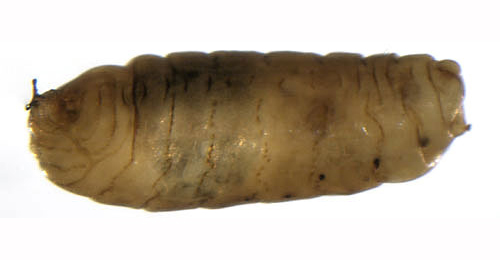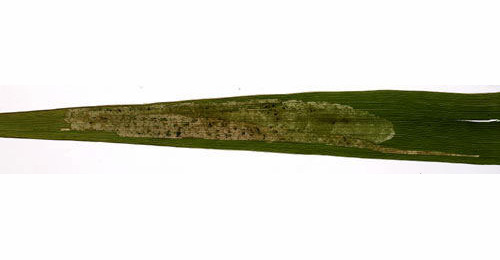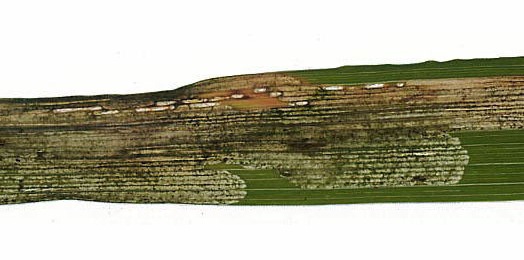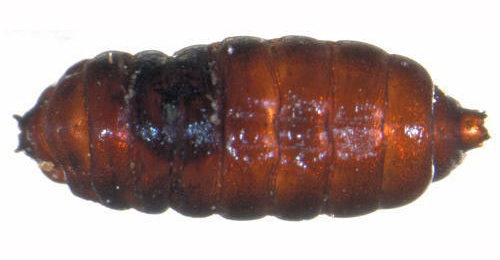|
||||||
|
TRISETUM. Yellow oat grass. [Poaceae] |
|
Two species of Trisetum are recorded in Britain. These include the native Yellow Oat-grass (T. flavescens). The BSBI provide a downloadable plant crib for subspecies of Trisetum flavescens. Thirteen British miners are recorded on Trisetum. Nearly 100 British miners or possible miners are recorded on grasses in Britain. A key to the European miners recorded on Trisetum is provided in Bladmineerders van Europa. It is recommended that adults of all miners on grasses be reared to be certain of their identity. |
Key for the identification of the known mines of British |
Note: Diptera larvae may live in a corridor mine, a corridor-blotch mine, or a blotch mine, but never in a case, a rolled or folded leaf, a tentiform mine or sandwiched between two more or less circular leaf sections in later instars. Pupation never in a cocoon. All mining Diptera larvae are leg-less maggots without a head capsule (see examples). They never have thoracic or abdominal legs. They do not have chewing mouthparts, although they do have a characteristic cephalo-pharyngeal skeleton (see examples), usually visible internally through the body wall. The larvae lie on their sides within the mine and use their pick-like mouthparts to feed on plant tissue. In some corridor miners frass may lie in two rows on alternate sides of the mine. In order to vacate the mine the fully grown larva cuts an exit slit, which is usually semi-circular (see Liriomyza huidobrensis video). The pupa is formed within the hardened last larval skin or puparium and as a result sheaths enclosing head appendages, wings and legs are not visible externally (see examples). See Key to non-Diptera. |
1a > Leaf-miner: Long, narrow, whitish mine. Pupation internal (Spencer, 1976: 453); anterior spiracles projecting through the epidermis. Whitish, upper-surface, rather narrow corridor with comparatively large frass grains that are laying further apart than their diameter. Pupation within the mine. The anterior spiracles of the orange-brown puparium penetrate the epidermis. |
 Chromatomyia nigra larva, lateral Image: © Willem Ellis (Bladmineerders van Europa) |
 Chromatomyia nigra pupa, lateral Image: © Willem Ellis (Bladmineerders van Europa) |
|
Chromatomyia nigra (Meigen, 1830) [Diptera: Agromyzidae]. |
1b > Leaf-miner: Pupation external or internal. If internal then anterior posterior spiracles not projecting through the epidermis. |
1c > Leaf-miner: Narrow whitish mine, with frass in distinct black lumps. Pupation internal (Spencer, 1976: 422). Whitish, upper-surface, descending corridor, about halfway up the blade. Frass in distinct black grains that are lying further apart than their diameter. Pupation in the mine. |
|
| Chromatomyia fuscula (Zetterstedt, 1838) [Diptera: Agromyzidae]. |
2a > Leaf-miner: Broad elongated mine; the form is dependent of the leaf form of the host plant. Frass green. Usually a number of larvae together in a mine. Pupation in the mine. |
|
Cerodontha incisa (Meigen, 1830) [Diptera: Agromyzidae]. |
2b > Leaf-miner: Larvae feed singly, forming an upper surface linear-blotch mine. Pupation either internal or external. Puparium reddish, brown or black, loosely glued to the leaf. |
 Mine of Agromyza albipennis on Phalaris arundinacea Image: © Willem Ellis (Bladmineerders van Europa) |
|
Agromyza albipennis Meigen, 1830 [Diptera: Agromyzidae]. |
2c > Leaf-miner: Larvae either singly or several in leaf, then forming large blotch, feeding first up and then down the leaf. Pupation external; puparium adhering to the leaf near end of mine, puparium black or dark red |
|
Agromyza lucida Hendel, 1920 [Diptera: Agromyzidae]. |
2d > Leaf-miner: Larval leaf-mine starts as a narrow channel running towards apex of leaf but later develops into a broad blotch running downwards. Frass largely diffused, giving the mine a characteristic greenish appearance. Pupation external (Spencer, 1976: 126). Corridor, usually several in one leaf, running from close to the leaf base up to near the tip, then reversing direction and widening, resulting in one communal mine in which the larvae descend in a common front. Frass somewhat deliquescent, mine therefore strikingly green. Pupation outside the mine. Neither mine nor larva distinguishable from those of mobilis. Puparium reddish brown |
|
Agromyza nigrella (Rondani, 1875) [Diptera: Agromyzidae]. |
2e > Leaf-miner: The young larva first feeds towards the apex of the leaf, later turning and feeding downwards. Several larvae can occur together in a single leaf. Pupation external, puparium reddish brown |
 Mine of Agromyza nigrociliata on Arrhenatherum elatius Image: © Willem Ellis (Bladmineerders van Europa) |
 Agromyza nigrociliata puparium Image: © Willem Ellis (Bladmineerders van Europa) |
|
| Agromyza nigrociliata Hendel, 1931 [Diptera: Agromyzidae]. |
2f > Leaf-miner: Mine greenish with only single larva, initially running towards apex of leaf before turning back down and developing into a broad blotch. Puparium reddish brown |
|
Agromyza rondensis Strobl, 1900 [Diptera: Agromyzidae]. |
2g > Leaf-miner: A narrow whitish linear mine, running down the leaf from the apex, with frass in two rows of separate grains. Pupation external (Spencer, 1976: 246). Narrow corridor from start to end, whitish, uppper- or lower-surface, genarally running downwards. Mine often along the leaf margin. Frass in distict grains of regular size, alternating along the sides of the corridor. Pupation outside the mine. |
 Mine of Liriomyza flaveola on Festuca gigantea Image: © Willis Ellis (Bladmineerders van Europa) |
|
Liriomyza flaveola (Fallén, 1823) [Diptera: Agromyzidae]. |
2h > Leaf-miner: A short narrow mine, generally near apex of leaf. |
|
Pseudonapomyza atra (Meigen, 1830) [Diptera: Agromyzidae]. |
|
Key for the identification of the known mines of British |
Note: The larvae of mining Coleoptera, Hymenoptera and Lepidoptera may live in a corridor mine, a corridor-blotch mine, a blotch mine, a case, a rolled or folded leaf, a tentiform mine or sandwiched between two more or less circular leaf sections in later instars. Larva may pupate in a silk cocoon. The larva may have six legs (although they may be reduced or absent), a head capsule and chewing mouthparts with opposable mandibles (see video of a gracillarid larva feeding). Larvae of Hymenoptera and Lepidoptera usually also have abdominal legs (see examples). Frass, if present, never in two rows. Unless feeding externally from within a case the larva usually vacates the mine by chewing an exit hole. Pupa with visible head appendages, wings and legs which lie in sheaths (see examples). |
| 1a > Leaf-miner: The larva mines from the grass tip downwards and the mine occupies half or the whole of the leaf blade width. A whitish blotch is formed with characteristic narrow streaks of frass. Full depth blotch, slightly inflated, descending from the leaf tip, occupying half or the entire width of the blade. The larva may move and make a new mine elsewhere. In the latter case the mines are fairly short; otherwise an entire blade may be mined out. Frass in a some narrow greyish brown streaks. Pupation outside the mine. |
|
Elachista albifrontella (Hübner, 1817) [Lepidoptera: Elachistidae]. |
1b > Leaf-miner: The larvae mine the blades of various grasses, including meadow-grass and cock's-foot. Long, flat, whitish, relatively broad corridor descending from the leaf tip. Frass irregularly scattered. The larva may make several mines during its lifetime. Pupation outside the mine. |
|
Elachista freyerella (Hübner, 1825) [Lepidoptera: Elachistidae]. |
1c > Leaf-miner: Larva makes a large whitish blotch and mines the leaf downwards. The frass tends to be deposited in the upper part of the mine. Oviposition usually not far from the leaf tip. From there descends an irregular blotch mine. Hering (1957a) describes the mine as flat and quite shallow, giving it a greenish, rather than whitish appearance. Frass initially in the oldest, upper part of the mine, later in strings. The larva can leave its mine and restart elsewhere. Normally only one larva per mine, but sometimes two or even three mines in a leaf. Pupation outside the mine. |
|
Elachista maculicerusella (Bruand, 1859) [Lepidoptera: Elachistidae]. |
| Last updated 05-Feb-2018 Brian Pitkin | ||
